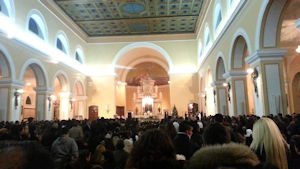Read in Albanian Skënderbeu
from the well-known Danish historian Ludvig Holberg.
Klementi XI – Albani

HISTORY OF SHKODRA
More history…
The immured woman
Our Lady’s legend
In Albanian
Historia e ‘Rozafës’
Historia e Oso Kukës
Archdiocese of Scutari (SCUTARENSIS)
The first known bishop was Bassus (387). The bishops of Scutari were at first subject to the Metropolitan of Salonica, Primate of all Illyricum, but when Justinian I transferred the primacy to Achrida, they became suffrages of the latter see. In the early Middle Ages Scutari was suffrage of Dioclea. From the seventh to the middle of the twelfth century no bishop is known.
Among its best-known bishops are: Francis II de Sanctis (1471-1491); Fra Dominicus Andrijasevic (died at Rome in 1639), a famous theologian and philosopher, friend of Gregory XV and of Urban VIII; Dominicus II Babic (1677-1686); Antonius III de Nigris (1693-1702), martyred in 1702 by the Turks.
In 1867 Scutari was que principaliter united with the Archdiocese of Antivari, and in this way Pius IX made Scutari an archdiocese and metropolis. The first archbishop of the united diocese, Mgr. Charles Pooten, native of Teveran near Aachen, who had been Apostolic Administrator of Antivari (1834-1855), died at Scutari on 15 January, 1886.
From 1063 to 1886 only 53 bishops of Scutari are known. On 23 October, 1886, the Archdiocese of Scutari was separated from that of Antivari, and remained an archdiocese and a metropolis with three suffragans: Alessio, Sappa, and Pulati. The ancient See of Ulcinium, in the territory of Scutari, was in 1571 occupied by the Turks and ceased to exist, for no Christians remained. During the existence of Ulcinium, its bishops were suffrages of the Metropolitan of Antivari or of that of Dioclea.
About the middle of the sixteenth century the ancient See of Suacium was forever suppressed. Other ancient sees in this territory were the Sees of Dinnastrum and Balazum. The Archdiocese of Scutari comprises 29 parishes, of which 8 are held by Franciscans, and has a Catholic population of about 33,807. Its present metropolitan is Mgr. Paschalis Guerini, born at Pezzagno in Dalmatia, 21 May, 1821; ordained priest on 27 June, 1848; appointed Coadjutor Bishop of Scutari and titular Bishop of Paphos on 6 May, 1879; elected as Metropolitan and Archbishop of Scutari on 23 November, 1886. The Episcopal residence is at Scutari.
The Archdiocese of Scutari has a Collegium Pontificium Albaniense founded as a central seminary (1853) by the Holy See. Burned and again destroyed by the Turks, it was reopened in 1859, the Emperor of Austria, Francis Joseph I, bearing two-thirds of the expense. The Austrian Government supported at first fifteen seminarians, now twenty-four; Propaganda supports ten; the remaining eleven are at the charge of their bishops. It is administered by the Jesuits. A preparatory school, the Collegium S. Francisci Xaverii, was opened in 1841 by the Jesuits, to which in 1868, by the wish of Pius IX, a course of philosophy was added and later a trade-school (Handelsschule).
The Franciscans have a college or so-called probandat at Scutari and a novitiate at Rubigo. The Scolopii have an orphanage for boys, and there is also an orphanage for poor girls. There are Sisters of Charity of St. Vincent de Paul, and four Catholic elementary schools. The Franciscans have hospices at Arra e madhe – Scutari and at Kastrati, and a monastery at Scutari. The schools and colleges are sustained mostly by the Propaganda and by the Austrian Government.
L i t e r a t u r e
FARLATI, Illyricum sacrum, VII, 304-334; GAMS, Series episcoporum Eccl. Cath. (Ratisbon, 1873, 1886), 408; THEINER, Monumenta Slavorum, I, nn. 170, 254, 284, 285, 286, 352, 368, 640; II, nn. 78, 228 (p. 214), 233 (p. 217-18); NARKOVIC, Dukljansko-barska metropolija (Zagreb, 1902), 39 sq.; NIHACEVIC, Iz Albanije o Albaniji u “Serafinskom Perivoju” (Lijevno-Sarajevo, 1909), Godina XXIII, 126-129. ANTHONY-LAWRENCE GANCEVIC, Transcribed by Douglas J. Potter. Dedicated to the Immaculate Heart of the Blessed Virgin Mary




